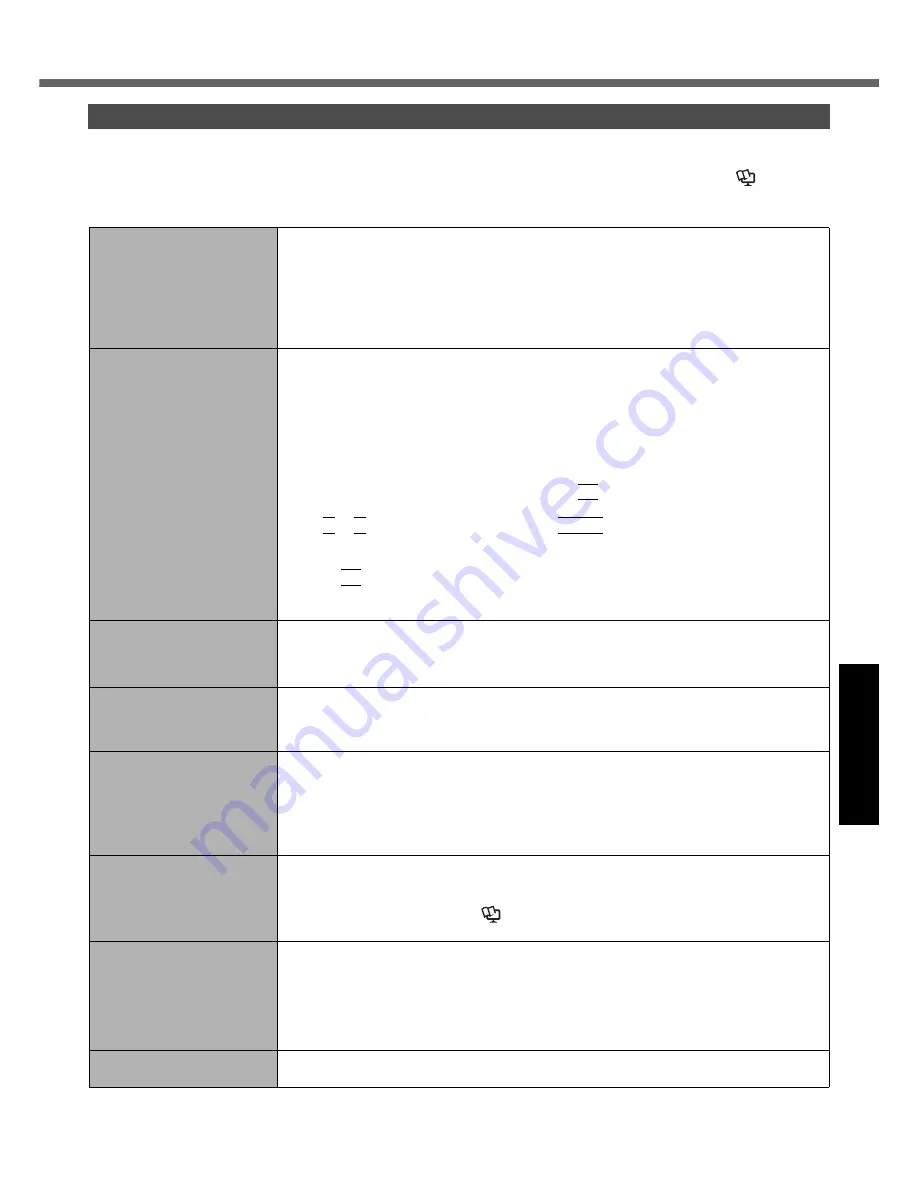
29
Get
ting St
arted
U
seful In
formati
on
Troubleshooting
Appendix
Troubleshooting (Basic)/Error Code/Message
Follow the instructions below when a problem has occurred. There is also an advanced troubleshooting guide in the
“Reference Manual”. For a software problem, refer to the software’s instruction manual. If the problem persists, contact
your technical support office. You can also check the computer’s status in the PC Information Viewer (
Reference
Manual
“Check the Computer’s Usage Status”).
Troubleshooting (Basic)
Starting Up and Standby and Hibernation Mode
The computer does not
power on/
The power indicator or bat-
tery indicator is not lit.
Connect the AC adaptor.
Insert a fully charged battery.
Remove the battery pack and the AC adaptor, then connect them again.
If an additional RAM module has been inserted, remove the RAM module and check to
see if the RAM module is the recommended one.
When the CPU temperature is high, the computer may not start up to prevent overheating of
the CPU. Wait until the computer cools down, and then turn the power on again. If the com-
puter does not power on even after cooling down, contact your technical support office.
Windows does not start up.
Remove all peripheral devices.
• If a device is connected to the USB port, disconnect the device or set [Legacy USB
Support] to [Disable] in the [Advanced] menu of the Setup Utility.
If an additional RAM module has been inserted, remove the RAM module and check to
see if the RAM module is the recommended one.
If the power indicator is lit, slide the power switch for four seconds or longer to turn off,
then turn on again.
Using the following procedure, start up in Safe Mode, and check the error details.
A
Turn on the computer, and when the [Panasonic] boot screen disappears (after enter-
ing the password
*1
if one is set) hold down
F8
.
B
Release your finger when the Windows Advanced Options Menu appears, and with
or , select [Safe Mode], then press
Enter
.
Follow the onscreen instructions.
*1
Supervisor Password or User Password set with the Setup Utility
Press
F9
in the Setup Utility (
page 32 “To start the Setup Utility”) to return the Setup
Utility settings (excluding the passwords) to the default values. Start the Setup Utility and
make the settings again.
There is a beep sound, and
either "Extended RAM Mod-
ule Failed" or "Standard
RAM Failed" appears
If "Extended RAM Module Failed" appears, the RAM module is not correctly inserted.
Turn off the computer, check that the RAM module is a recommended module, then
insert it correctly.
If "Standard RAM Failed" appears, contact your technical support office.
Cannot boot from optional
CD/DVD drive.
Make sure that the bootable CD/DVD is set properly.
Start the Setup Utility, and confirm the following settings.
• [USB Port] and [Legacy USB Support] are set to [Enable] in the [Advanced] menu.
• [USB CDD] is the first device shown in [Boot priority order] in the [Boot] menu.
You have forgotten the
password.
Supervisor Password or User Password: Contact
your technical support office
.
Administrator password:
• If you have a password reset disk, you can reset the administrator password. Set the
disk and enter any wrong password, then follow the on-screen instructions and set a
new password.
• If you do not have a password reset disk, reinstall (
page 27) and set up Windows,
and then set a new password.
Cannot log on to Windows
with the SD memory card.
The Windows user name and password may not set correctly on the SD memory card.
Enter the Windows user name and password without using the SD memory card. After
logging on to Windows, set the same user name and the password on the SD memory
card and Windows again. (
Reference Manual
“SD Security”)
Set [SD Slot] to [Enable] in the [Advanced] menu of the Setup Utility.
“Remove disks or other
media. Press any key to
restart” or a similar mes-
sage appears.
A floppy disk is in the floppy disk drive and it does not contain system startup informa-
tion. Remove the floppy disk and press any key.
This message may appear with some devices connected to
the USB port
. Remove the
device or set [Legacy USB Support] to [Disable] in the [Advanced] menu of the Setup Utility.
If the problem persists after removing the disk, it may be a hard disk failure. Perform the rein-
stallation and return the hard disk to its condition at the time of purchase.
(
page 27
)
If the
problem persists even after the reinstallation, contact
your technical support office
.
[Executing Battery Recali-
bration] screen appears.
The Battery Recalibration was canceled before Windows was shut down last time. To
start up Windows, turn off the computer by the power switch, and then turn on.






























